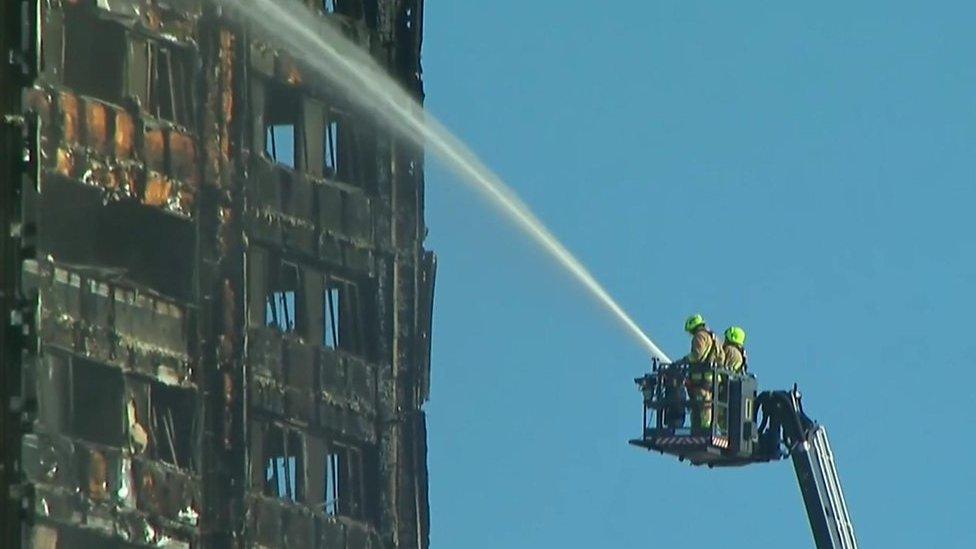Grenfell Inquiry: What five reports reveal
- Published
Five reports have been published at the start of the fact-finding stage of the public inquiry into the Grenfell Tower fire, in which 72 people died. They cover the tower's safety measures, how the fire spread and the evacuation. Here are the key findings.
Professor Niamh Nic Daeid: Cause and spread of fire
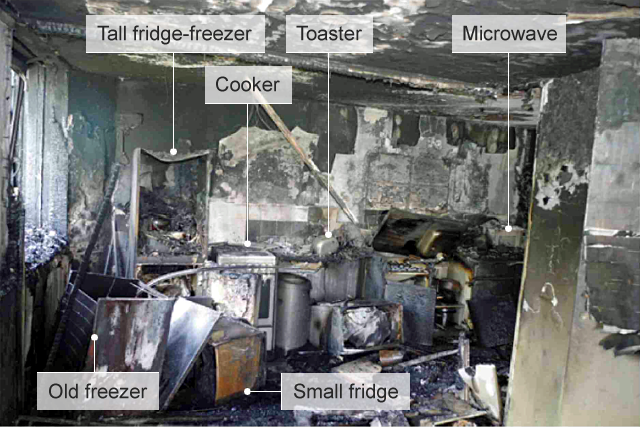
The kitchen in flat 16 where the fire started
Professor Nic Daeid, an expert in forensic science at the University of Dundee, concluded there was "insufficient information and analysis" to determine the exact cause of the fire which occurred in flat 16 on the 4th floor of Grenfell Tower.
Her report said the fire began in the south-east corner of the kitchen - and "it is more likely than not that this was in or around the area of the tall fridge-freezer".
Laminate flooring underneath the fridge-freezer had a burn pattern not seen on the rest of the floor, suggesting the floor immediately under the appliance was exposed to more heat than that on either side of it, it said.
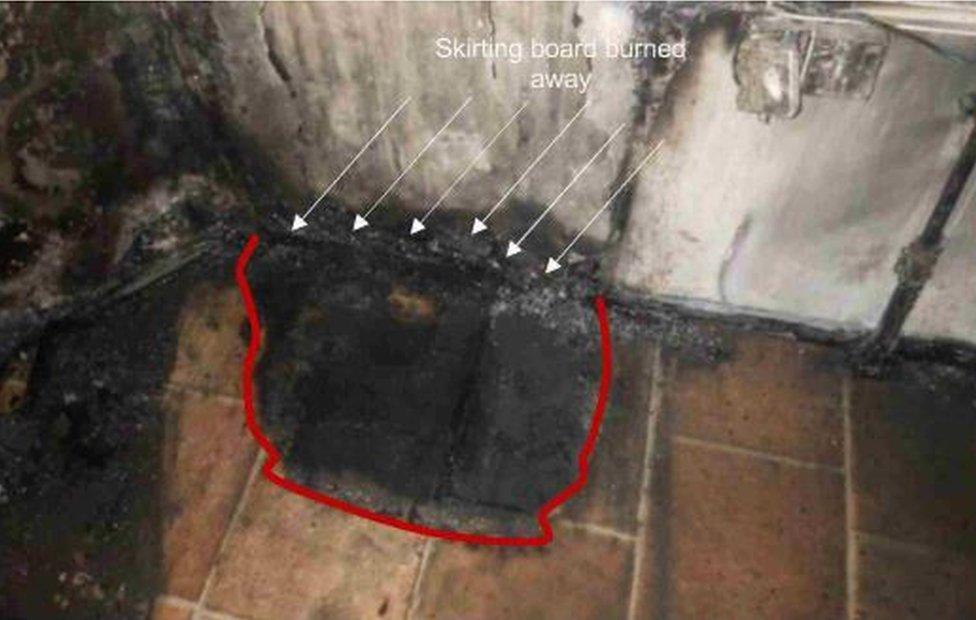
The burn marks underneath the fridge-freezer in flat 16

The report found the fire left the flat via the kitchen window, and "at some point re-entered through the window of the bedroom next to the living room of flat 16 causing further damage to the flat".
The fire was "more likely than not to be accidental cause and not a deliberate act".
It said a further examination of electrical materials recovered from the flat by a forensic electrical engineer was needed to determine what caused the fire.
"No in-depth analysis of the electrical system or combustibility analysis of the tall fridge-freezer of related artefacts has been undertaken by any fire investigator. Only visual non-destructive examinations have taken place so far," it said.
Dr Barbara Lane: Fire protection measures
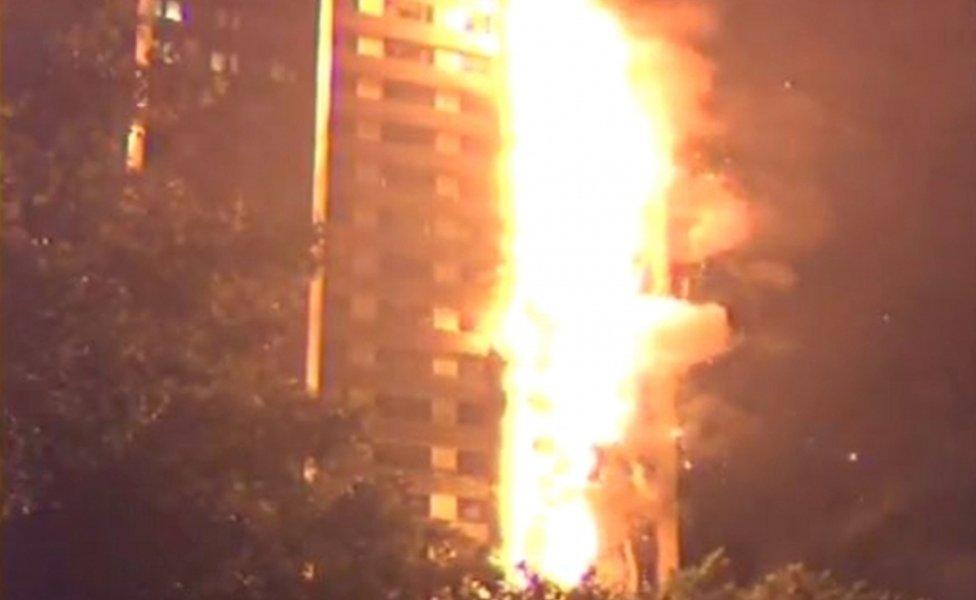
The fire pictured at 01.26, by which point the 'stay put' policy had 'effectively failed'
Dr Lane, a chartered fire engineer, said advice to "stay put" during the Grenfell Tower fire had "effectively failed" within around half an hour of the blaze starting.
When the fire was first reported at 00:54 BST, residents were initially given advice to "stay put" inside the building but this advice had "effectively failed" by 01:26, her report said.
A change in policy recommending residents try to leave was not made until 02:47 BST, one hour and 53 minutes after the first emergency call.
She said there was "an early need for total evacuation of Grenfell Tower" but it was not an "easy decision to make".
Dr Lane also said that cladding on Grenfell Tower did not comply with recommended fire performance criteria.
Multiple fires were allowed to spread because of combustible materials by the windows and within the cladding system.

Whilst attempts had been made to construct fire stopping compartments within the cladding, they were "installed incorrectly, and no evidence has been provided that they were ever tested for performance in the type of cladding installed at Grenfell Tower," the report said.
Dr Lane's report also said:
Flat entrance doors were non-compliant with fire test evidence and doors going to the stairs "do not appear to have been upgraded since installation in 1972"
The ventilation system - which was meant to prevent smoke from entering the stairwell - did not appear to work as intended
Issues with fire lifts meant they could not be used to transport equipment or residents up and down the building
The fire service had to pump its own water into Grenfell Tower - the building's "dry fire main" system was "non-compliant" with guidance at the time of construction and is "non-compliant with current standards".
"The number of non-compliances signify a culture of non-compliance at Grenfell Tower," the report said.
Professor Luke Bisby: Ignition of the facade materials
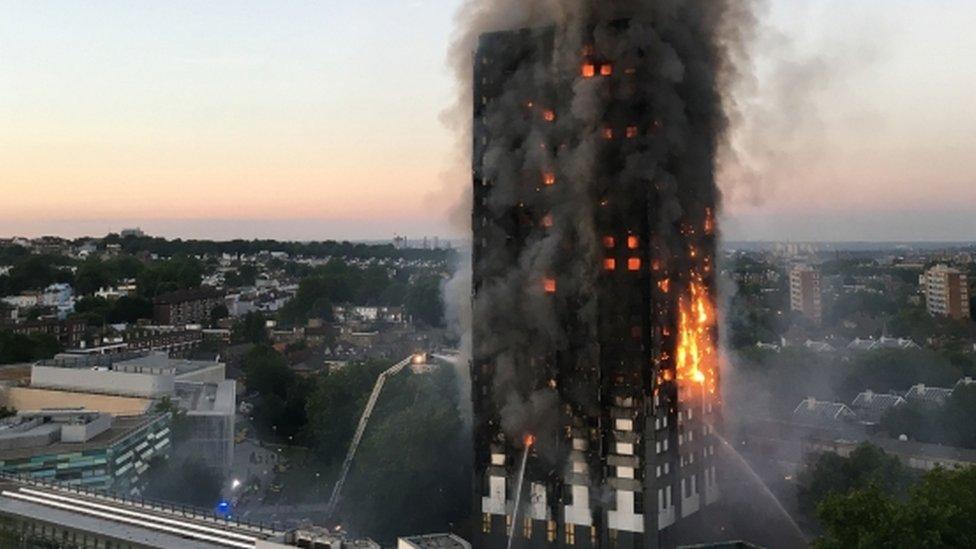
Polyethylene material in the cladding was the primary cause of the spread of the fire
Professor Bisby, an expert in fire and structures at the University of Edinburgh, said evidence "strongly supports" the hypothesis that polyethylene material in the cladding on Grenfell was the primary cause of the fire's spread.
"The ACM (aluminium composite material) product on Grenfell Tower incorporates a highly combustible PE polymer filler which melts, drips, and flows at elevated temperature. The polyethylene filler material is expected to release large amounts of energy during combustion, to rapidly lose its mechanical properties, and to cause the separation of the ACM panels and cassettes," his report said.
Using this type of cladding on buildings should be carefully considered as it represents a "clear and significant" fire hazard, it warned.
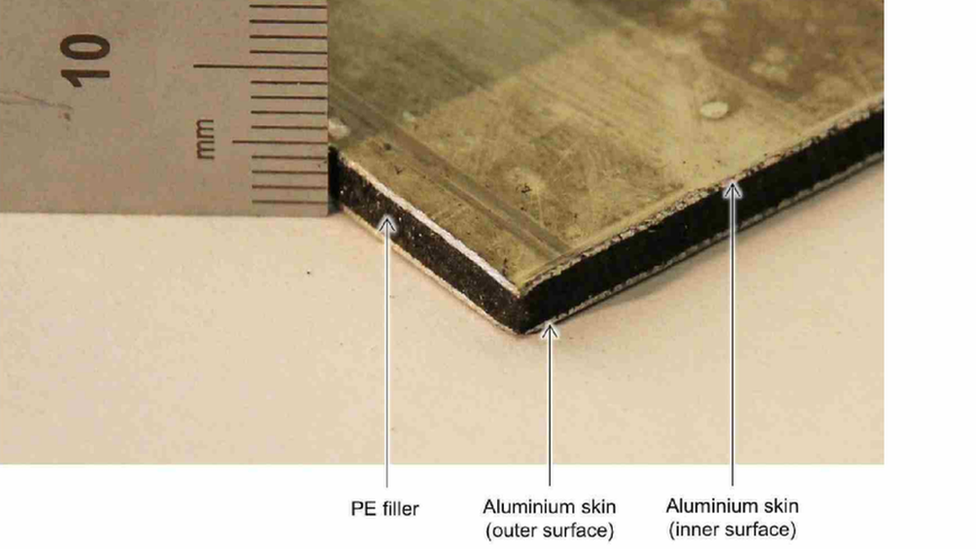
The report also found that vertical cavities within the cladding structure played a role in the spread of the fire, as did the insulation, although evidence was inconclusive.
The wind was not thought to be a significant factor.
Prof Bisby also recommended the inquiry consider why firefighters doused the cladding immediately below the original fire - while it was still small - but not above or to the side.
Professor Jose Torero: Spread of the fire
Grenfell Tower inquiry: What questions will be answered?
The report by Prof Jose Torero, a global fire safety expert at the University of Maryland, said a "stay put" strategy was appropriate while the fire was contained to flat 16, but not once the fire started to spread up the building.
Once the fire had breached the flat - the "second phase" - it would have been better for residents to have left their flats and exited the building.
During the third phase of the fire - once it had begun to spread internally - there were effectively no good options for evacuating the occupants of the tower, he said.
"The building is operating outside conditions contemplated by the existing regulatory framework, firefighting operations are outside the bounds of conventional practice. The magnitude of the event has significantly reduced the capacity of the fire service to manage the situation."
His report strongly criticised the existing systems and culture of buildings compliance, saying the shift in complexity which occurs when intricate facade systems are incorporated into high rise buildings means that functional requirements, guidelines, and tests become inadequate to assess performance.
"The inadequacy of these methods of performance assessment/regulation is such that systems that introduce obvious dangers can be incorporated by designers in a routine manner," it said.
"There is a need to shift from a culture that inappropriately trivialises 'compliance' to a culture that recognizes complexity in 'compliance' and therefore values 'competency', 'performance' and 'quality'. Otherwise, the increasing complexity of building systems will drive society in unidentified paths towards irresponsible deregulation by incompetency," the report added.
Colin Todd: Statutory and regulatory requirements
Mr Todd, a fire safety consultant, said Building Regulations 2010 require "the external walls of the building shall adequately resist the spread of fire over the walls and from one building to another".
"In relation to Grenfell Tower, without wishing to pre-empt the findings of the Inquiry, it is the first part of the sentence contained within Requirement B4 (1) that is greatly significant.
"While, clearly, interpretation of this requirement rests, to a great extent, on the meaning of the word 'adequately', the intent of this requirement is, in my opinion, to minimize the potential for external spread of fire from one floor to another. While it is well-known that the dynamics of fire can, potentially, result in the external vertical spread of fire from one flat to the flat immediately above, via windows, rapid spread significantly beyond such an extent would, in my opinion, demonstrate a failure to comply with [the] requirement," the report said.
It also said the London Building Act says councils might require a "higher standard of external enclosure of the building than would otherwise be necessary" for high buildings.
However, the report points out that Local Government Authority guidance notes that "high rise does not mean high risk".
"After a fire breaks out, there is no greater likelihood of a fatality in a high-rise block than a low rise block or, indeed, a bungalow. This is because very few people die as a result of a fire in a neighbour's flat. Nearly all fire deaths in blocks of flats occur in the flat in which fire starts."

Day-by-day: the inquiry so far

- Published30 May 2018

- Published21 May 2018

- Published23 May 2018
